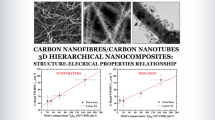Abstract
Carbon nanofibers (CNFs) have a remarkable electrical conductivity resulting highly attractive for different applications such as composites or electronics due to their high quality/price ratio. Although it is known that their graphitic character provides a high conductivity, very little is known about the influence of the nanofibers structure on that property. In this study, CNFs characterized by different physical properties are prepared at diverse synthesis temperatures within a range (550–750 °C) in which significant structural and dimensional changes are accomplished and homogeneous nanofiber growth takes place. The electrical conductivity is determined on the powdery as-grown materials modifying the compaction degree by applying pressure. Because of a combination of structural features, the apparent electrical conductivity increases with synthesis temperature of CNFs, ranging from 50 S m−1 for the worst conducting CNFs at a low compaction degree (25 % of solid volume fraction) to 3 × 103 S m−1 for the best conducting CNFs at a high compaction degree (60 % of solid volume fraction). Further analysis is carried out applying the percolation theory to analyze the experimental data and the results suggest that both the orientation of the graphenes and the filament diameter distribution play a determining role in the intrinsic electrical conductivity with values in the interval 1.5 × 103 to 1.3 × 104 S m−1. These intrinsic values of electrical conductivity are found between one and two orders of magnitude higher than that of the powder, highlighting the also important effect of porosity.












Similar content being viewed by others
References
Endo M, Kroto HW (1992) J Phys Chem 96:6941–6944
Chung DDL (2004) J Mater Sci 39:2645–2661. doi: 10.1023/B:JMSC.0000021439.18202.ea
Al-Saleh MH, Sundararaj U (2009) Carbon 47:2–22
Tibbetts GG, Lake ML, Strong KL, Rice BP (2007) Comp Sci Technol 67:1709–1718
Kubota S, Nishikiori H, Tanaka N, Endo M, Fujii T (2005) J Phys Chem B 109:23170–23174
Liu Q, Ren W, Chen ZG, Yin L, Li F, Cong H, Cheng HM (2009) Carbon 47:731–736
Huang J, Liu Y, Hou H, You T (2008) Biosens Bioelectron 24:632–637
Kim C (2005) J Power Sources 142:382–388
Xuyen NT, Ra EJ, Geng HZ, Kim KK, An KH, Lee YH (2007) J Phys Chem B 111:11350–11353
Barranco V, Lillo-Ródenas MA, Linares-Solano A, Oya A, Pico F, Ibáñez J, Agullo-Rueda F, Amarilla JM, Rojo JM (2010) J Phys Chem C 114:10302–10307
Endo M, Kim YA, Hayashi T, Nishimura K, Matusita T, Miyashita K, Dresselhaus MS (2001) Carbon 39:1287–1297
Antolini E (2009) Appl Catal. B 88:1–24
Shao Y, Liu J, Wang Y, Lin Y (2009) J Mater Chem 19:46–59
Rodríguez NM, Chambers A, Baker RTK (1995) Langmuir 11:3862–3866
De Jong KP, Geus JW (2000) Catal Rev Sci Eng 42:481–510
Díez-Pascual AM, Naffakh M, González-Domínguez JM, Ansón A, Martínez-Rubi Y, Martínez MT, Simard B, Gómez MA (2010) Carbon 48:3500–3511
Yang DJ, Wang SG, Zhang Q, Sellin PJ, Chen G (2004) Phys Lett A 329:207–213
Yang SB, Kong BS, Geng J, Jung HT (2009) J Phys Chem C 113:13658–13663
Park HJ, Oh KA, Park M, Lee H (2009) J Phys Chem C 113:13070–13076
Park YT, Ham AY, Grunlan JC (2010) J Phys Chem C 114:6325–6333
Kim YJ, Kim YA, Chino T, Suezaki H, Endo M, Dresselhaus MS (2006) Small 2:339–345
Ismagilov ZR, Shalagina AE, Podyacheva OY, Ischenko AV, Kibis LS, Boronin AI, Chesalov YA, Kochubey DI, Romanenko AI, Anikeeva OB, Buryakov TI, Tkachev EN (2009) Carbon 47:1922–1929
Jiménez P, Castell P, Sainz R, Ansón A, Martínez MT, Benito AM, Maser WK (2010) J Phys Chem B 114:1579–1585
Charlier JC, Issi JP (1996) J Phys Chem Solids 57:957–965
Frackowiak E, Béguin F (2001) Carbon 39:937–950
Kinoshita K (1988) Carbon: electrochemical and physicochemical properties. Wiley, New York
Kuznetsov VL, Butenko YV, Chuvilin AL, Romanenko AI, Okotrub AV (2001) Chem Phys Lett 336:397–404
Pandolfo AG, Hollenkamp AF (2006) J Power Sources 157:11–27
Sebastián D, Suelves I, Moliner R, Lázaro MJ (2010) Carbon 48:4421–4431
Lázaro MJ, Sebastián D, Suelves I, Moliner R (2009) J Nanosci Nanotechnol 9:4353–4359
Pinilla JL, Suelves I, Lázaro MJ, Moliner R, Palacios JM (2008) Int J Hydrogen Energy 33:2515–2524
Tuinstra F, Koenig JL (1970) J Chem Phys 53:1126–1130
Patrick JW (1985) Porosity in carbons. Edward Arnold, London
Kuvshinov GG, Mogilnykh YI, Kuvshinov DG, Zaikovskii VI, Avdeeva LB (1998) Carbon 36:87–97
Suarez-Martínez I, Grobert N, Ewels CP (2012) Carbon 50:741–747
Snoeck JW, Froment GF, Fowles M (1997) J Catal 169:240–249
Fenelonov VB, Derevyankin AY, Okkel LG, Avdeeva LB, Zaikovskii VI, Moroz EM, Salanov AN, Rudina NA, Lokholobov VA, Shaikhutdinov SK (1997) Carbon 35:1129–1140
Celzard A, Marêché JF, Payot F, Furdin G (2002) Carbon 40:2801–2815
Euler KJ (1978) J Power Sources 3:117–136
Ehrburger-Dolle F, Lahaye J, Misono S (1994) Carbon 32:1363–1368
Pantea D, Darmstadt H, Kaliaguine S, Roy C (2003) Appl Surf Sci 217:181–193
Sebastián D, Calderón JC, González-Expósito JA, Pastor E, Martínez-Huerta MV, Suelves I, Moliner R, Lázaro MJ (2010) Int J Hydrogen Energy 35:9934–9942
Acknowledgements
The authors wish to thank FEDER and the Spanish MICINN for the financial support to project CTQ2011-28913-C02-01. The authors also acknowledge the support of bilateral CNR (Italy)–CSIC (Spain) joint agreement 2011–2012 (project Baglio/Lazaro 2010IT0026).
Author information
Authors and Affiliations
Corresponding author
Rights and permissions
About this article
Cite this article
Sebastián, D., Ruiz, A.G., Suelves, I. et al. On the importance of the structure in the electrical conductivity of fishbone carbon nanofibers. J Mater Sci 48, 1423–1435 (2013). https://doi.org/10.1007/s10853-012-6893-1
Received:
Accepted:
Published:
Issue Date:
DOI: https://doi.org/10.1007/s10853-012-6893-1




